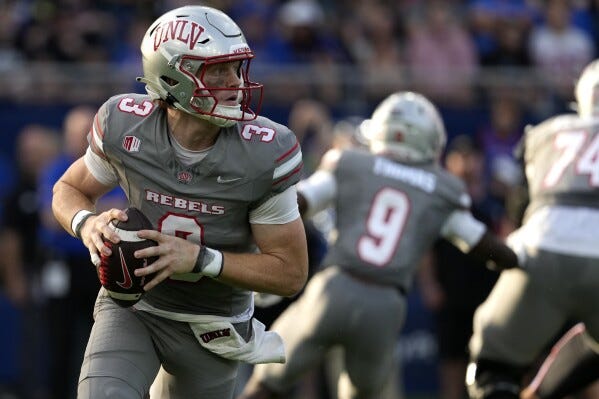UNLV should pay its quarterback. That’s the main takeaway of this post, but the odd circumstance of a QB leaving an undefeated team after 3 games has motivated me to write down thoughts that have been bouncing around my head for awhile.
The basic premise is that college football’s still-nascent ability to pay players is not in a sustainable equilibrium. This isn’t exactly a hot take, as players, coaches and lawyers have all opined, and major changes could be coming.
Even if schools have a de facto1 salary cap of $20M/year to directly pay players, there will still be structural differences to its closest sibling — the NFL — that make me question whether college football will ever reach an equilibrium.
But those ideas are too much to include in a single post, so they’ll be coming in a series of posts over the next few weeks. I’ll start with a more tractable example: UNLV and its disgruntled QB, Matthew Sluka, who is leaving the team over a disputed $100k NIL deal.
UNLV’s Playoff Payoff
In my mind, the main reason the current NIL rules lead to irrational financial decisions is because payment and on-field performance aren’t strongly linked. Obviously, there’s some relationship between how much money a player can command and his past performance. But in the NFL, players’ contracts include incentives and bonuses for performance. Score a certain amount of touchdowns, reach a certain amount of tackles, intercept a certain number of passes, and earn more money at the end of the season.
While most NIL deals are very murky, I doubt the same on-field incentive structure exists. This boils down to an issue that NIL collectives2 have to pay players before they see them perform. It’s hard to gauge how a player might play, and you usually have to pay “market rates” for a player without a ton of data on whether those rates are “worth it.”
However, UNVL’s situation offers a rare instance when they can clearly quantify the value of paying a player an incremental $100k because i) it’s coming 3 games into the season and ii) the “payoff” is more clear.
With the new 12-team playoff, the highest ranked Group of 5 conference champion is guaranteed a spot. At the very least, UNLV making the CPF would net them $6M3. That’s not counting the value of exposure from playing in the CFP game, incremental donations from an enthused fan base and any other upside.
Even the lowball $6M figure makes it clear that UNLV should pay Sluka — assuming that he’s the best QB on the team. We can distill the scenarios into the two outcomes of the decision (Pay Sluka or Do Not Pay) and the outcomes of the season (Make CFP or Do Not Make CFP).
This is obviously a vast, vast oversimplification. If UNLV doesn’t make the CFP, they could still make a bowl game that comes with some payout. But using these simplified scenarios and some expected value math, we can find the “breakeven” probability for UNLV.
Right now, The Athletic gives UNLV an 18% chance of making the playoff. Plugging that number into our scenarios, UNLV’s expected value of paying Sluka is nearly $1M ($980k to be exact)4. That’ still an outside chance of making the playoff, about the same odds as rolling a 7 from a pair of dice5, but the payoff would be huge.
Of course, if UNLV lets Sluka walk, they could still make the playoff and reap the huge upside. The “breakeven” probability is 16.3%. That is, UNLV would be indifferent to paying Sluka if the next QB on the roster gave them about the same chance of making the playoff, plus they’d save on giving Sluka his money.
A single loss could easily swing UNLV’s playoff chances by more than 1.7%. Sluka has already led a fun comeback win against Kansas. Would his backup have been able to do the same? Would his backup be able to produce roughly the same moving forward?
Sluka has been quite pedestrian according to Neil Paine’s Points Above Replacement metric, ranking 80th, in the same ballpark as Jackson Arnold (OU), who just lost his starting job; Payton Thorne (Auburn), who’s being openly criticized by his coach; and Jacolby Criswell (UNC), who started the season third on the depth chart.
So it’s possible that Sluka’s replacements could muster the same performance and UNLV should let him go. But I’d bet that the disruptions of making a mid-season QB change are likely to derail a hopeful season. And I’m not the only one.
Since the story broke, UNLV’s spread for this week’s game against Fresno State has moved to -1.5 from -3.5. That single data point would be enough to justify that losing Sluka would lower UNLV’s playoff odds below the breakeven point.
For a team that plays in a city that’s well-versed in risk-taking and expected value — and where $100k feels like pocket change — they should be comfortable with this type of thinking.
Obviously, the math misses the crucial human component of the story. Sluka’s decision has kicked off hand wringing and discussion across college football. If UNLV’s coaches and players feel the situation is more blackmail than blackjack, Sluka wouldn’t be the teammate and leader necessary to navigate them to the CFP even with his $100k.

De jure might be the more correct phrase here, but it’s still unclear how all this would work
Throughout this post, I’m conflating the schools and the NIL collectives that actually pay the players. I’ve delve into the mechanics — and why they matter — in a future post
$980k = $6M * 18% + -$100k * 82%



